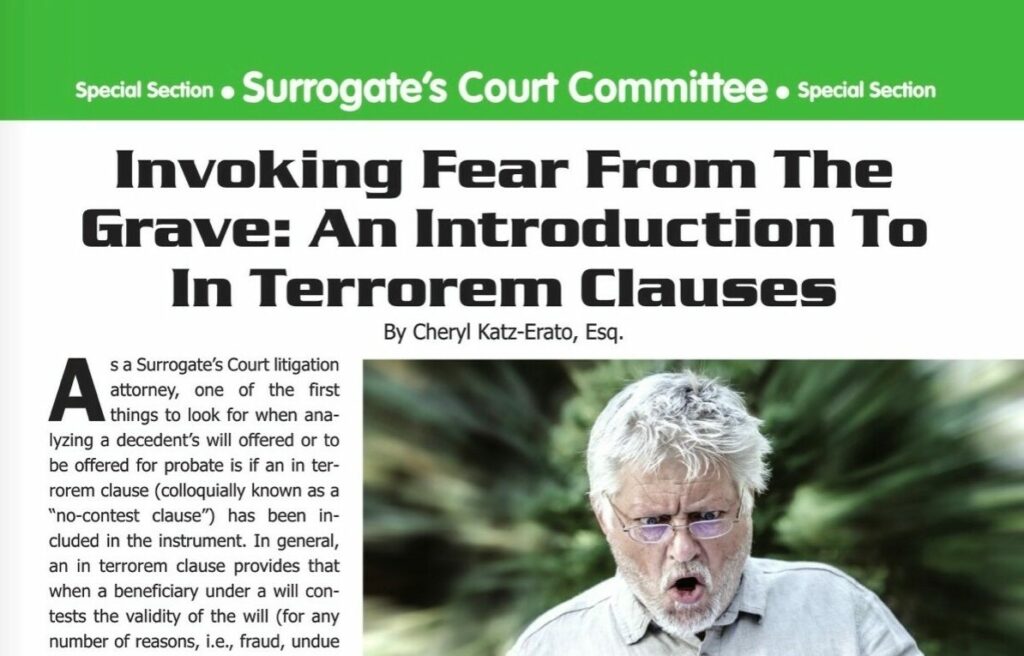
Invoking Fear From The Grave: An Introduction To In Terrorem Clauses
By Cheryl Katz-Erato
As a Surrogate’s Court litigation attorney, one of the first things to look for when analyzing a decedent’s will offered or to be offered for probate is if an in terrorem clause (colloquially known as a “no-contest clause”) has been included in the instrument. In general, an in terrorem clause provides that when a beneficiary under a will contests the validity of the will (for any number of reasons, i.e., fraud, undue influence, testamentary incapacity, or improper execution) and is unsuccessful, such beneficiary forfeits all interests they would have received under that will.
Thus, when drafting a will, a seasoned trusts and estates attorney may in certain instances strategically include the in terrorem clause in an attempt to dissuade possibly litigious distributees from objecting to the will’s validity after the testator’s death. Consider this fact pattern: Testator, a widower, has two children: (i) GoodSon and (ii) BadSon. Testator wants to leave his entire $1 million probate estate to GoodSon (who will also be the nominated executor) and wholly disinherit BadSon who has been estranged from the family for years. Testator is advised by his attorney that such a testamentary plan will likely leave GoodSon, who undoubtedly wants to probate the will after death, subject to a lengthy and expensive contested proceeding instigated by disinherited BadSon. Thus, in attempt to prevent such litigation, the Testator could, for example, leave a specific bequest of $100,000 to BadSon under his will, along with the inclusion of an in terrorem clause. That way, once GoodSon offers the will to probate after Testator’s death, BadSon will think twice about contesting its validity. Indeed, if BadSon initiates an unsuccessful will contest, the in terrorem clause will be triggered and BadSon will forfeit any interest he had in the estate (his entire $100,000 bequest). In this fact pattern, such a bequest and the clause together likely act as a litigation deterrent.
Alternatively, consider this fact pattern: Testator has two children: (i) GoodSon and (ii) BadSon. Testator plans to leave his entire $1 million probate estate to GoodSon and leave a specific bequest of $100 to BadSon with an in terrorem clause. In this instance, the bequest and clause together will not act as litigation deterrent due to the insignificant bequest given to BadSon. The takeaway is that for an in terrorem clause to be properly utilized, the will must provide the potential objectant with something “substantial” to achieve the desired litigation deterrent effect. Of course, this determination is highly fact specific, and what is considered “substantial” is identified on a case-by-case basis.
Notwithstanding the above, just because an in terrorem clause is included in a will does not mean that there will not be in any litigation. New York’s Safe Harbor Provision[i] provides a potential objectant with an opportunity to participate in activities that will not trigger the clause or the possible resulting forfeiture. Thus, in our fact patterns above, despite the presence of the in terrorem clause, BadSon (potential objectant) will have an opportunity to conduct certain discovery before commencing a probate contest.
Under EPTL § 3-3.5, a potential objectant is entitled to a “preliminary examination. . . of a proponent’s witnesses, the person who prepared the will, the nominated executors and the proponents in a probate proceeding”.[ii] Such preliminary discovery is detailed in SCPA §1404 which provides, in relevant part: “[a]ny party to the proceeding, before. . .filing objections to the probate of the will, may examine any or all of the attesting witnesses, the person who prepared the will, and if the will contains [an in terrorem clause], the nominated executors in the will and the proponent”. [iii]
As demonstrated above, the inclusion of an in terrorem clause in a will essentially affords a potential objectant with more pre-objection discovery than they would otherwise have been entitled to. Attorneys considering the use of an in terrorem clause in a will must understand the ramifications and must ensure that if an in terrorem clause is included, the potential objectant is being left a bequest that is significant enough to achieve the intended deterrent effect; otherwise, the clause is not only meaningless, but it provides a result that is even more adverse to the testator’s wishes. These clauses should never be included as a boilerplate paragraph in a template form. Similarly, a trusts and estates litigation attorney who represents a potential objectant must act cautiously so their litigation tactics do not trigger the in terrorem clause, resulting in a total forfeiture of their client’s interests in the estate.
In sum, the use and implication of an in terrorem clause requires a careful analysis both during the will drafting process and also after a testator’s death. Indeed, when the clause is used properly, it is a highly effective tool that will successfully deter a lengthy and expensive probate contest.
Cheryl Katz-Erato is a Senior Associate at Cona Elder Law, Long Island’s award-winning Elder Law and Trusts and Estates law firm. Cheryl’s practice is devoted exclusively to trusts and estates, including estate litigation, estate and asset protection, probate and estate administration.
[i] See EPTL § 3-3.5
[ii] EPTL § 3-3.5
[iii] SCPA § 1404 (emphasis supplied)
About the Author Cona Elder Law
Related Posts
Understanding Legacy Contacts on Apple Devices: A Powerful Estate Planning Tool for Your Digital Assets
The Aging Prison Population: A Nursing Home Dilemma
On-the-Ball Older Adults: How to Travel Smart This Summer
How to Transfer Title to a Car After the Owner Passes Away
Transfer on Death Deeds: To Deed or Not to Deed?
Medical Aid in Dying Act Gains Momentum But Legislature Fails to Act

